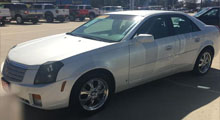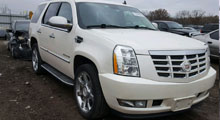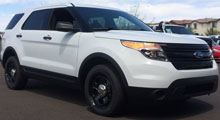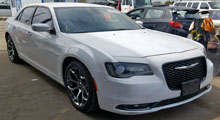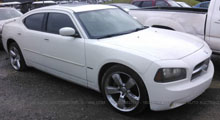Types Of RV's
With such a huge range of RVs available, it can be helpful to look at individual RV categories and to explore each type's most common features, alongside any pros and cons. While there can be huge variations between models within the same category, all RVs fall into one of two clearly defined classes: motorized or towable.

Motorized RVs
Motorized RVs have a built-in driving area and engine meaning there's no time wasted setting up or levelling, and any stoppage time can quickly be converted to leisure time. Convenience and comfort are key factors, although they are not without drawbacks, including manoeuvrability, storage space and cost. Motorized RVs come in three distinct classes: A, B and C.
Class A
Class A is undoubtedly the most luxurious RV you'll come across. Built on a custom-designed chassis, the class A offers a home-from-home experience and is suited to full-time living as it is long, far-flung trips. An average class A measures from 21 to 45 feet and sleeps up to 6, making it great for couples and families alike. Spacious, complete with dedicated sleeping areas and luxury amenities, it's easy to overlook some of the more commonly experienced disadvantages of class A ownership. Class As are large which means more space, but also makes them hard to turn in tight areas and an additional vehicle may be necessary for errand runs or exploring trips out and about. They also require a large storage area and those amenities and comfort come at a price.
Class B
Class B is often called a 'camper' or 'conversion van'. Nimbler and more fuel efficient than a class A, the class B is built on a conventional chassis with adaptations to increase living space, such as dropped floors and a raised roof. Great for shorter trips, class Bs seldom require the use of an additional vehicle and allow for more spontaneous exploration. However, in spite of their innovative use of space, class Bs can be on the small side for families, and they typically feature fewer amenities, while often converting living space into sleeping space.
Class C
Class C is almost comparable to a smaller version of a class A, offering luxury and space but with greater manoeuvrability, bringing together the best features of the class A and class B in one RV. It is often recognizable by its over-cab sleeping area and may feature slide-outs to further increase living space. Some larger vehicles in this range can be difficult to get into tight spaces and it's worth noting that the reduced head height in overhead areas can be problematic.
Towable RVs
Towable RVs remain an attractive, often cost-effective option for individuals and families alike. The range of accommodation is vast, and each category has many variants. Furthermore, towable RVs often depreciate more slowly in value than their motorized equivalents and don't require the same repairs and maintenance. However, some of the larger trailers may require specialized tow vehicles as only the lighter models can be towed by an average sedan, something to bear in mind when considering the difference in price between a motorized and a towable RV.
Travel Trailer
Perhaps the most versatile and well-known towable RV, the conventional travel trailer is available in a wide range of forms to suit all tastes, budgets and lifestyles. Ranging from 12 to 35 feet on average, the travel trailer features a standard hitch, which means a greater variety of suitable towing vehicles. Standard travel trailers can offer a range of amenities and storage space, as well as slide-out options. Upon arrival, they need to be set up and levelled, however this frees up your vehicle for further exploration.
Fifth Wheel
In recent years, the fifth wheel towable RV has become increasingly popular. It is often viewed as a great improvement on the travel trailer as its stability and spaciousness are enhanced by an extension to the trailer body that sits above the back of the tow truck. This allows for a two-level floor plan with higher ceilings and better weight distribution over the vehicles axles. However, bear in mind that the entire truck bed will be taken up by the trailer, meaning less storage space for your items. Also, not all vehicles are compatible with fifth wheel RVs.
Pop-Up
A less expensive, more traditional option to the fifth wheel is the pop-up RV or tent trailer. These affordable RVs come in a range of sizes, with differing, albeit limited options. The canvas walls of these RVs are designed to fold out when set up to provide extra space. Not only does this make them compact and easy to tow, but also lightweight, meaning you can probably find one that is suitable for your vehicle. Pop-up RVs offer an experience akin to camping, they take a while to set up, have a low temperature stability and offer a more rustic, down-to-earth experience.
Truck Camper
If you prefer exploring areas off the beaten track, the truck camper is the only RV you can take just about anywhere your pickup can go. Truck campers are portable units that are fitted directly on to the back of a pickup truck and provide protection from the elements in a compact, easy to drive set-up. An excellent way to experience the great outdoors, these RVs are really only suited to single occupants over short periods of time, with limited facilities.
Sport Utility RV
Also known as a SURV or a toy trailer, the sport utility RV combines storage and transportation for small vehicles with living space. Perfect for ATVs and motorcycles, these trailers feature ramps, easy to clean floors and walk through storage areas, ideal for sporting trips away and competitions. Size and amenities vary from model to model, although it is possible to increase living quarters with converted fifth wheel trailers, taking advantage of the extra sleeping compartment extension. Although extremely practical, SURVs are not to everyone's taste due to close proximity to chemicals and other vehicle hazards as well as a compact living space.
